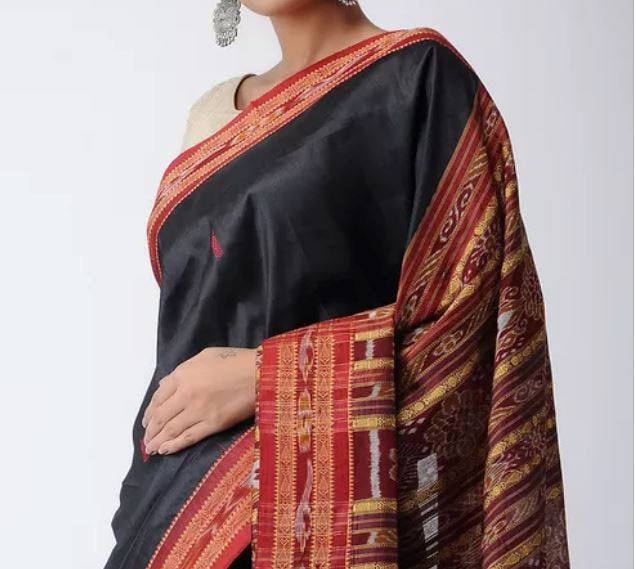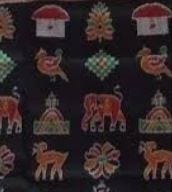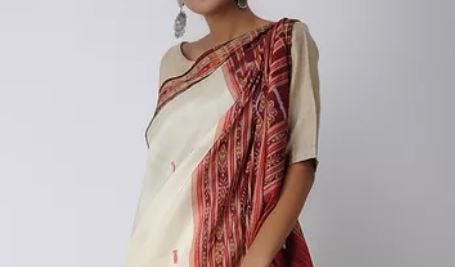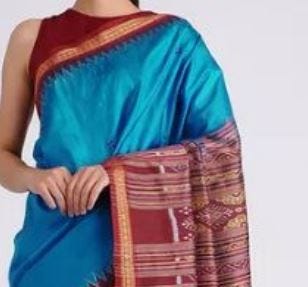Saree that identifies with the State Odisha
During my childhood, I knew pata saree (silk saree) meant Khandua which my mother used to wear for wedding ceremonies, festivals or on special occasions. Due to the place of origin of Khandua Pata which is from Cuttack and Maniabandha, the other two names given to Khandua Sarees is Kataki or Maniabandhi saree.
Now after some decades, I am wearing Khandua, my mother wears Khandua and my grand mother wears Khandua. This saree is perfect for women of all age groups. Khandua saree makes a woman look elegant, stylish and beautiful at the same time.
Origin of Khandua

Maniabandha and Nuapatna are neighbouring villages in Tigiria and Badamba blocks of Cuttack District at a distance of 100 kms from Bhubaneswar and around 80 kms from Cuttack. Both Maniabandha and Nuapatna and their surrounding villages are inhabited by a large number of weavers but most of them are into cotton ikat weaving. Only a handful of Nuapatna weavers are into silk weaving.
Khandua Pata/Silk Saree, the pride of Odisha is mainly woven in villages in Nuapatna and Maniabandha Blocks.
History
As per history, Jayadeva the great poet of 12th century, offered his ‘Gitagobinda’ to Lord Jagannath by way of fabrics. He got them woven in his native birthplace Kenduli village where the lyrics of the ‘Gitagobinda’ were woven in the fabric. The technique used for weaving the motifs on fabric was by tie-dye method. Then the King of Puri issued an order to Nuapatna (Tigiria) to supply Gitagobinda fabrics.

Khanduas are not only called ‘the pride of Odisha’ but they are rich in culture and heritage and closely associated with Lord Jagannath in many ways. Moreover, historically Lord Jagannath’s ‘Angavastra’ is made from Khandua fabric.
Other than Gitagobinda-Khandua-pata (silk), other cotton fabrics are also used in the daily rituals of the deities.
Khandua silk has plain body or small flower motifs across the body with contrast borders and pallu motifs like star, temple conch, Rudrakshya, fish, Chakra, Lotus, Swan, Peacock, Parrot, Deer, Elephant, Lion, dance of Devdasi, etc. Different types of sceneries are shown in a Khandua saree and the pallu has the motifs in horizonal rows.


Weaving Pattern
Khandua-Pata is woven with Malda Silk threads. The process of weaving involves a number of activities like winding, warping, design, setting, drafting, denting and weaving. The artisans use traditional charkha for winding the yarn in bobbin, mostly done by ladies. The elaborate process takes tens of hours to weave just one saree.

In Nuapatna, the weavers have a practice of doing tie-dye on the weft and the warp beam is generally a single colour. Border portion is warp tie-dye, whereas anchal/ Pallu is weft tie-dye.
The saree is initially composed in red, yellow, maroon, or cream shade.
The elephant in Khandua ikat from Nuapatna varies from elephant motives in ikat from Sambalpuri saree as well as ikat from other parts of Orissa. Khandua has plain borders in contrast to borders with motifs in case of the other ikat of Orissa.

Khandua is not only an age-old traditional handloom fabric, but a beautiful fabric, which can be used for any high-end garment. It is also famous for its tie-dye ‘temple borders’.

The weave varieties are Nabarangi, Tarabali, Gitagobinda-bastra and a lot others.
Maniabandha and Nuapatna , two villages are synonymous with the production of Khandua.
Marketability
Nowadays weavers are using other tie-dye technique to give more vibrant and beautiful clear motifs so as to increase the marketability. The best element of this Saree is it weighs barely 300 grams. Khandua Saree has kept its traditional value with a mix of new generation touch, as per present day requirement.

The saree can be seen being used by almost all the Odissi dancers who have performed the dance in India and abroad. The visual effect of the Sari is enchanting and widely cherished by many illustrious personalities.
Apart from Ikat weaving, the weavers of Maniabandha are masters in extra weft weaving.
Stay Safe, Stay happy and healthy. Take care of yourself and your family.



Leave a comment